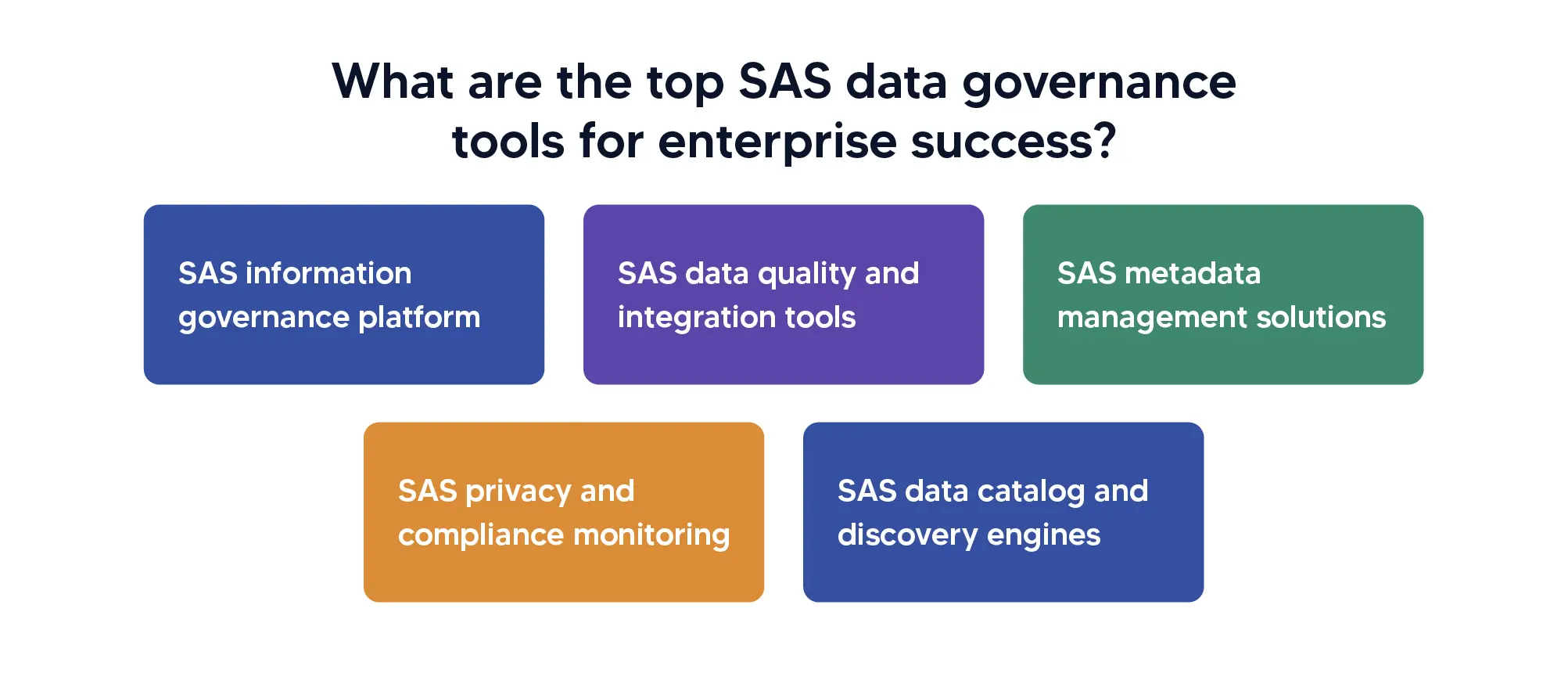Other recent blogs



Let's talk
Reach out, we'd love to hear from you!
Data governance emerged as the top priority for 65% of global data leaders and chief data analytics officers in 2024, surpassing AI-driven data analytics initiatives. No wonder the new-age organizations are now prioritizing formal data governance and quality like never before to achieve improved data-driven decisions rooted deeply in enhanced efficiency and greater transparency. As we navigate 2026, SAS Data Governance stands at the forefront of this transformation, offering enterprises a comprehensive approach to managing, securing, and maximizing their data assets. Here’s the proof:
The convergence of Artificial Intelligence with Data Analytics demands strict regulatory compliance and business intelligence. This has positioned SAS Data Governance as a critical strategic imperative. In this playbook, we will explore the top SAS Data Governance capabilities every business leader should understand, from foundational frameworks to advanced automation tools that are reshaping how organizations harness data for competitive advantage.
What is SAS data governance, and why does it matter for modern businesses?
SAS Data Governance represents a comprehensive approach to managing an organization's data assets through policies, procedures, and technologies that ensure data quality, accessibility, and security. At its core, it establishes a framework where data becomes a strategic business asset rather than just a byproduct of operations.
The foundation of an effective SAS data governance framework rests on four critical pillars:
- Data quality management: ensures that information flowing through business systems maintains accuracy, completeness, and consistency. This pillar addresses the fundamental challenge of poor data quality, which costs organizations an average of $12.9 million annually.
- Data security and privacy: encompass comprehensive protection mechanisms, including access controls, encryption, and compliance with regulations like GDPR and CCPA. This becomes increasingly vital as organizations face mounting pressure from investors, regulators, and consumers for greater transparency in data management practices.
- Data lineage and metadata management: provide visibility into data origins, transformations, and dependencies across the enterprise ecosystem. This transparency enables organizations to understand data flow and maintain trust in analytical outcomes.
- Regulatory compliance and risk management: ensure adherence to industry standards and governmental regulations while minimizing exposure to data-related risks. This pillar has become particularly crucial as 62% of organizations identify data governance as the greatest impediment to AI advancement due to concerns surrounding data lineage, quality, and privacy.
How does SAS data management integrate with governance initiatives?
SAS Data Management seamlessly integrates with governance initiatives by providing a unified platform that combines data integration, quality assessment, and governance oversight. The platform enables organizations to discover, profile, and catalog data assets automatically while maintaining comprehensive governance controls throughout the data lifecycle.
This integration supports self-service analytics while ensuring governance policies remain enforced, creating an environment where business users can access trusted data without compromising security or compliance requirements. Let’s now understand how SAS data governance works in practice.
Well, SAS data governance operates through an integrated ecosystem of tools and processes that automate data discovery, enforce quality standards, and maintain comprehensive oversight of data assets across the enterprise.
The platform begins with automated data discovery agents that scan enterprise systems to identify and catalog data assets. These automated agents accelerate data discovery while ensuring governance and confidential information monitoring through comprehensive information privacy assessments.
Once discovered, data undergoes quality assessment and profiling to establish baseline metrics for accuracy, completeness, and consistency. The system then applies predefined governance policies to classify data based on sensitivity, compliance requirements, and business criticality.
Understanding the role of automation in streamlining data management
Automation serves as the backbone of modern SAS data governance, eliminating manual processes that traditionally created bottlenecks and inconsistencies. Automation is growing more common in business software as organizations need to scale repetitive tasks across vast data landscapes, and this trend is particularly pronounced in data governance.
Key automation capabilities include intelligent data classification, which automatically categorizes data based on content, context, and regulatory requirements, ensuring appropriate governance policies apply without manual intervention. Policy enforcement automation continuously monitors data access, usage patterns, and compliance status, triggering alerts and remediation actions when violations occur.
Quality monitoring and correction automatically detect data quality issues and either correct them through predefined rules or escalate them to appropriate stakeholders for resolution. Workflow orchestration streamlines approval processes, data requests, and governance tasks through automated routing and notifications, reducing time to access while maintaining control.
What are the top SAS data governance tools for enterprise success?
Modern enterprises require sophisticated tools for SAS data management and governance that can handle complex and multi-cloud environments while providing intuitive interfaces for diverse user groups. Here are five types fof SAS Data Governance tools that define enterprise-grade data governance:

SAS information governance platform
The SAS Information Governance platform serves as the central hub for comprehensive data management, offering built-in data quality, integration, and lineage tools with a self-service UI that provides views of required data preparation steps, plus one-click access to SAS Viya analytics applications from data assets in the data catalog.
This platform excels in environments requiring tight integration between governance and analytics, enabling organizations to maintain data quality while accelerating time-to-insight for business users.
SAS data quality and integration tools
These tools address the fundamental challenge of maintaining data accuracy and consistency across disparate systems. They provide real-time data quality monitoring, automated cleansing capabilities, and seamless integration pathways that ensure governed data flows efficiently throughout the organization.
The integration capabilities support both batch and streaming data scenarios, making them suitable for modern architectures that combine traditional data warehouses with real-time analytics requirements.
SAS metadata management solutions
Comprehensive metadata management solutions provide the foundation for data discovery, lineage tracking, and impact analysis. These tools automatically capture technical, business, and operational metadata, creating a comprehensive data dictionary that supports both governance and analytics initiatives.
Advanced metadata capabilities include semantic modeling, relationship mapping, and automated documentation generation, which reduce manual effort while improving data understanding across the organization.
SAS privacy and compliance monitoring
Privacy and compliance monitoring tools address the growing complexity of regulatory requirements across multiple jurisdictions. These solutions automatically identify sensitive data, apply appropriate protection mechanisms, and generate compliance reports that demonstrate adherence to regulations like GDPR, CCPA, and industry-specific standards.
The tools provide real-time monitoring of data access patterns, automated consent management, and right-to-be-forgotten capabilities that ensure ongoing compliance without disrupting business operations.
SAS data catalog and discovery engines
Modern data catalog solutions serve as the searchable inventory of organizational data assets, providing business users with self-service discovery capabilities while maintaining governance oversight. These engines use machine learning to automatically tag, classify, and recommend data assets based on business context and usage patterns. Advanced discovery capabilities include natural language search, collaborative annotation, and usage analytics that help organizations understand which data assets drive the most business value.
How does a data catalog impact SAS data management success?
The data catalog serves as the strategic centerpiece of successful SAS data management initiatives, transforming how organizations discover, understand, and utilize their data assets. Unlike traditional data inventories, modern catalogs provide intelligent, searchable interfaces that democratize data access while maintaining governance controls.
Data catalogs dramatically reduce the time required for analysts and data scientists to locate relevant information by providing comprehensive metadata, lineage information, and business context that enables users to assess data fitness for purpose and understand preparation requirements quickly.
Catalogs further encourage collaborative data environments by enabling users to share insights, annotations, and recommendations about data assets. This crowdsourced approach to data documentation improves overall data literacy while reducing dependency on technical teams for basic data understanding.
Social features within catalogs, including ratings, reviews, and usage statistics, help organizations identify high-value data assets and promote best practices across teams. Additionally, data catalogs provide unprecedented visibility into data usage patterns, access rights, and compliance status.
This transparency enables governance teams to identify potential risks proactively and ensure policies remain effective as data landscapes evolve. Automated compliance reporting capabilities within catalogs streamline audit processes and demonstrate regulatory adherence without manual effort.
What are the common SAS data challenges and their proven solutions?
Organizations implementing SAS data governance frequently encounter predictable challenges that can derail initiatives if not addressed proactively. Understanding these challenges and their proven solutions enables more successful implementations.
Data silos and fragmented governance
Many organizations struggle with disconnected data systems that operate under different governance standards, creating inconsistencies and compliance gaps. Implementing federated governance models that establish common policies while allowing system-specific adaptations. SAS Information Governance provides a definition of central policy with distributed enforcement capabilities that respect existing system architectures while ensuring consistency.
Poor data quality and trust issues
Inconsistent, incomplete, or inaccurate data undermines analytical initiatives and creates reluctance among business users to rely on data-driven insights. When you deploy continuous data quality monitoring with automated correction capabilities, you establish data quality scorecards that provide transparency into data fitness and track improvement over time. Implement data lineage tracking that enables root cause analysis when quality issues occur.
Complex compliance requirements
Organizations operating across multiple jurisdictions face overlapping and sometimes conflicting regulatory requirements that complicate governance implementation. To address requirements at global, regional, and local levels, layered compliance frameworks must be developed. Automated classification and protection mechanisms should be used to apply appropriate controls based on data content and location. Privacy-by-design principles should be implemented to embed compliance into data processing workflows.
Balancing governance with accessibility
Overly restrictive governance can create bottlenecks that inhibit business agility, while insufficient controls create risk exposure. Implement risk-based access controls that provide appropriate freedom based on data sensitivity and user roles. Deploy self-service capabilities with embedded governance that enable business users to access data independently while maintaining compliance. Use automated approval workflows that expedite low-risk requests while ensuring proper oversight for sensitive data.
Cultural resistance and adoption barriers
Technical solutions alone cannot ensure governance success; organizations must address cultural factors that influence user behavior and adoption. Develop comprehensive change management programs that emphasize business value rather than compliance requirements. Provide targeted training programs that demonstrate how governance tools improve individual productivity. Establish governance champions within business units who can advocate for best practices and support peer adoption.
Which SAS data governance frameworks are dominating in 2025 and beyond?
The evolution of data governance frameworks reflects the increasing complexity of modern data environments and the need for more sophisticated approaches that balance control with agility.

The DMBOK-enhanced SAS governance framework
The Data Management Body of Knowledge (DMBOK) provides the theoretical foundation for many successful SAS data governance framework implementations. This framework emphasizes comprehensive data management across eleven knowledge areas, from data architecture to data security.
SAS implementations of DMBOK principles typically focus on establishing clear data ownership models, implementing comprehensive metadata management, and creating sustainable governance processes that scale with organizational growth.
Agile governance frameworks for digital transformation
Modern SAS data governance framework approaches embrace agile methodologies that enable rapid adaptation to changing business requirements while maintaining control standards. These frameworks prioritize iterative improvement, continuous feedback, and flexible policy enforcement.
Key characteristics include sprint-based governance development, continuous monitoring and adjustment, and cross-functional governance teams that can respond quickly to emerging requirements.
Cloud-native governance architectures
With cloud implementations set to advance at a 22.8% CAGR between 2025-2030, governance frameworks must accommodate multi-cloud and hybrid environments. SAS cloud-native governance frameworks provide consistent policy enforcement across on-premises and cloud environments while leveraging cloud-specific capabilities. These frameworks emphasize API-driven governance, containerized policy enforcement, and elastic scaling that matches cloud infrastructure capabilities.
AI-driven governance frameworks
The integration of artificial intelligence into governance processes represents a significant advancement in framework sophistication. SAS has unveiled a new agentic AI framework within Viya that allows organizations to design AI agents with varying degrees of autonomy, supporting human-in-the-loop oversight customized based on task complexity, risk tolerance and business goals. AI-driven frameworks provide intelligent policy recommendations, automated anomaly detection, and predictive governance that anticipates issues before they impact business operations.
What does the future hold for SAS data governance?
The trajectory of SAS data governance points toward increasingly intelligent, automated, and business-aligned solutions that reduce friction while enhancing control and insight generation.
Autonomous governance capabilities
Future SAS data governance solutions will incorporate autonomous capabilities that require minimal human intervention for routine governance tasks. These systems will automatically adapt policies based on usage patterns, risk assessments, and regulatory changes while maintaining human oversight for strategic decisions. Machine learning algorithms will continuously optimize governance processes, identifying bottlenecks and suggesting improvements that enhance both compliance and business agility.
Real-time governance and continuous compliance
The shift toward real-time analytics demands governance capabilities that operate at the speed of business. Future solutions will provide continuous compliance monitoring, instant policy enforcement, and real-time risk assessment that enables organizations to maintain governance standards without sacrificing analytical speed. Stream processing integration will enable governance policies to apply to data in motion, ensuring consistent control regardless of data velocity or processing architecture.
Democratized governance through intelligent automation
Advanced automation will democratize governance capabilities, enabling business users to participate in governance processes without deep technical expertise. Natural language interfaces, automated policy generation, and intelligent recommendations will make governance more accessible while maintaining professional standards.
Ecosystem integration and interoperability
Future SAS data governance platforms will seamlessly integrate with broader data and analytics ecosystems, supporting vendor-neutral governance policies that span multiple platforms and technologies. API-first architectures will enable governance capabilities to integrate with emerging technologies and business applications.
Transform your data governance strategy with Kellton's expertise
As organizations navigate the complexities of modern data governance, partnering with experienced specialists becomes essential for success. Kellton brings deep expertise in SAS data governance implementations, combining technical proficiency with strategic business understanding to deliver governance solutions that drive real business value.
Our approach begins with a comprehensive assessment of your current data landscape, identifying governance gaps and opportunities for improvement. We design customized SAS data governance frameworks that align with your business objectives while addressing regulatory requirements and risk management needs.
Kellton's proven methodology includes stakeholder alignment workshops, technical architecture design, implementation support, and ongoing optimization services that ensure your governance investment delivers sustained returns. Our team of certified SAS professionals and data governance specialists provides end-to-end support from strategy development through operational excellence.
Ready to transform your data governance strategy?
Contact Kellton today


